Every tech leader has been there: staring at an ambitious product roadmap with too few developers to make it happen. You need talent fast, but traditional hiring moves at glacial speed.
Meanwhile, freelance platforms promise instant access to global developers at budget-friendly rates.
Fiverr claims to offer a solution: immediate access to thousands of developers at competitive rates. But does the platform really deliver qualified technical talent?
I spent years testing Fiverr’s developer marketplace firsthand. I posted projects, interviewed candidates, managed deliverables, and evaluated code quality. The results surprised me in several ways.
This review cuts through the marketing claims with specific observations from actual projects. You’ll learn:
- The true skill level of Fiverr developers (based on delivered code, not profiles)
- Exact pricing structures, including all fees and hidden costs
- Which dev projects work best (and which fail) on Fiverr
- What other tech leaders say about their Fiverr experiences
- How Fiverr stacks up against Lemon.io and other platforms
- Clear criteria to decide if Fiverr fits your hiring needs
Tech hiring decisions impact your product quality, timeline, and budget. This review gives you the specific information you need to decide if Fiverr deserves a place in your talent strategy.
How Fiverr Works for Developer Hiring
Fiverr operates on a gig-based marketplace model where developers create packaged service offerings at fixed prices. The platform hosts over 550 programming-related subcategories, from WordPress customization to Unity game development.
The platform uses a star-based review system with public feedback visible on profiles. Seller levels (New, Level 1, Level 2, Top Rated) indicate experience within the Fiverr marletplace rather than professional qualifications.
For example, you can see below these programmers have labels like Level 2, Fiverr’s Choice, and Top-Rated:

Then, if you switch the tab to Pro catalog, you’ll find a mix of Vetted Pros and Fiverr’s Choice picks:
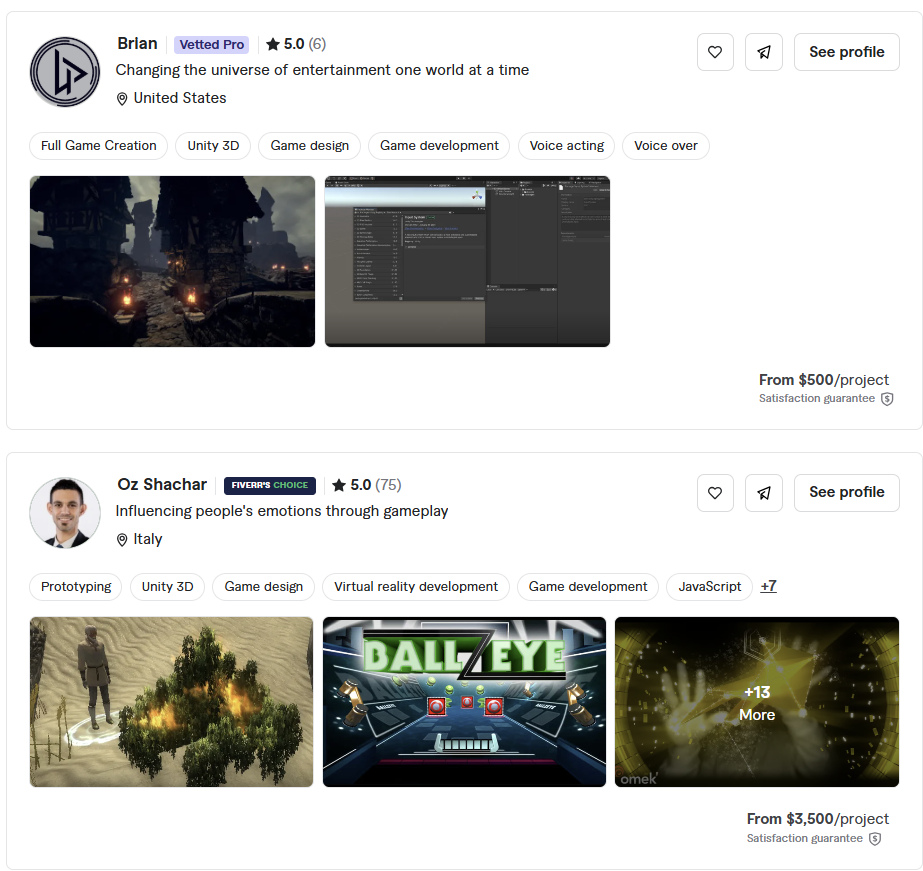
At the bottom of certain profiles, you’ll see key indicators to watch for, like “clients keep coming back” (my favorite) and “highly responsive”:

Developers set their own rates and delivery schedules rather than bidding on your specific project requirements.
Communication happens through Fiverr’s built-in messaging system. The platform handles all payments, holding your funds in escrow until you approve deliverables.
Search filters let you narrow options by price, delivery time, seller level, and programming language. However, Fiverr lacks technical vetting—anyone can create a developer profile regardless of actual skills.
Payment processing fees total 5.5% of your purchase, with an additional $2 small order fee for orders under $50. Withdrawal fees apply when sellers transfer earnings to external accounts, such as $3 for local bank transfer or $1–$3 for the Fiverr Revenue Card.
What About Fiverr Pro?
Fiverr Pro is the platform’s premium tier featuring manually vetted freelancers. Unlike regular Fiverr, Pro sellers undergo a formal application process that reviews their credentials, previous work, and professional background.
The difference? Higher quality but significantly higher prices. Pro developers typically charge $75-200+ per hour compared to regular Fiverr rates. My experience with Pro developers wasn’t that much better—more reliable communication and fewer technical issues—but still faced challenges with complex projects.
Pro works best when you need higher quality for a specific, well-defined task but still can’t risk the uncertainty of regular Fiverr.
Here’s a look into the Fiverr Pro dashboard:
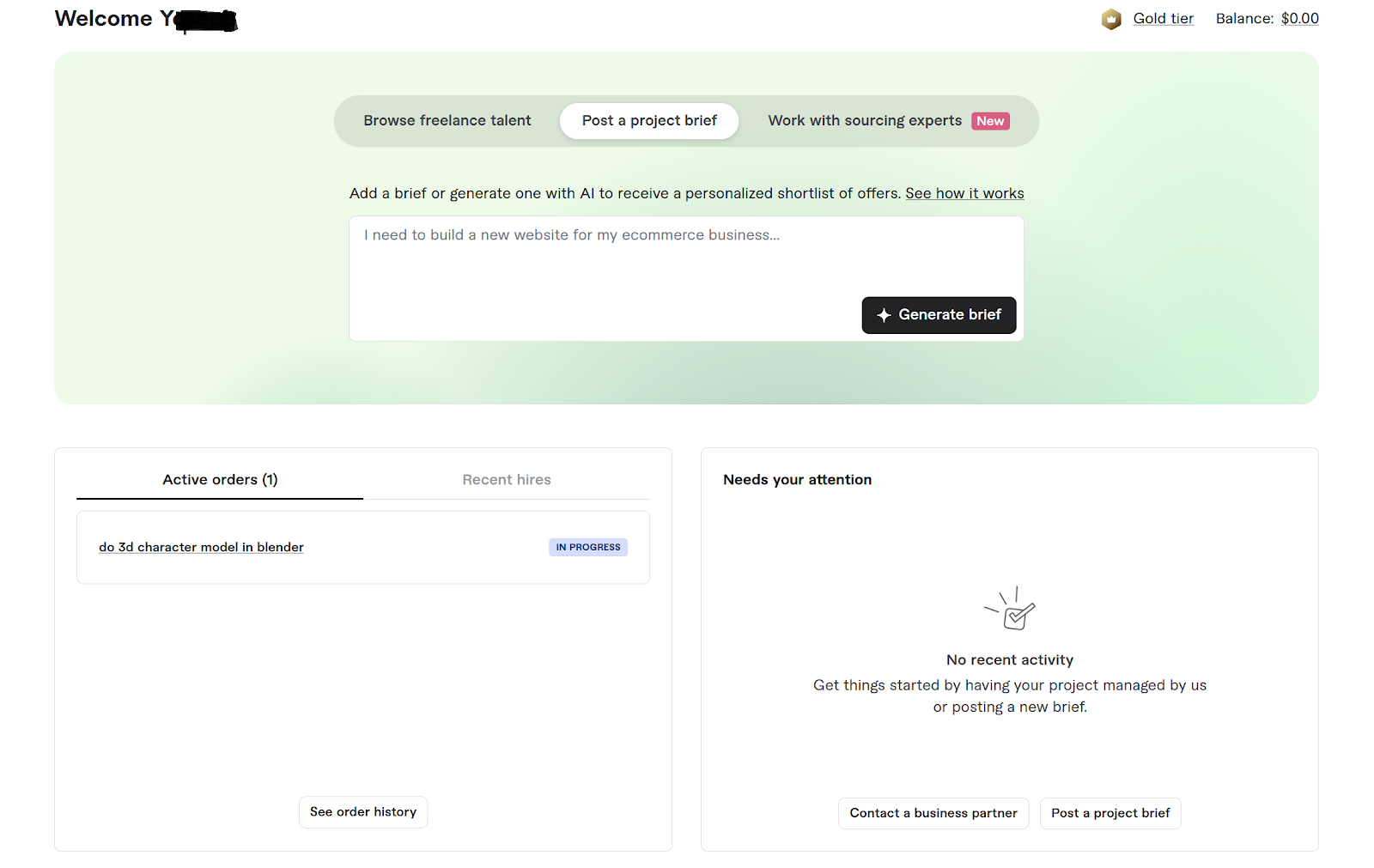
It features several tools and widgets where you can use AI-generated briefs to give to potential freelance collaborators. And it shows your pending orders and any items that need your attention.
Scroll down and you’ll see your recently viewed freelancers. Helpful for when you forget to “heart” them before moving along:
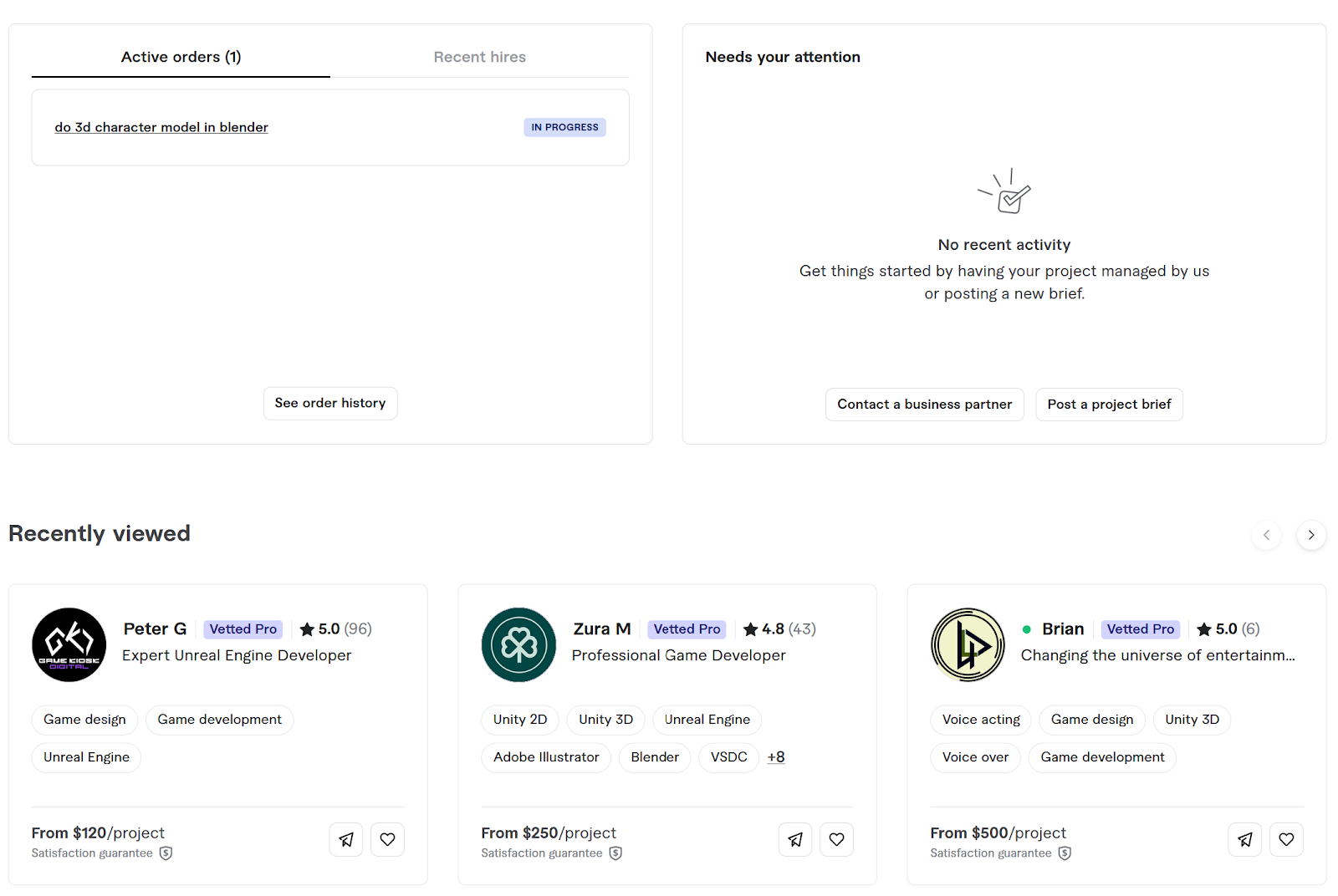
Then an inch lower, you’ll find an area where you can generate briefs, add payment methods, and bring your freelancers into one team (I’ve been wanting to try this, but can’t seem to put a solid team together…).
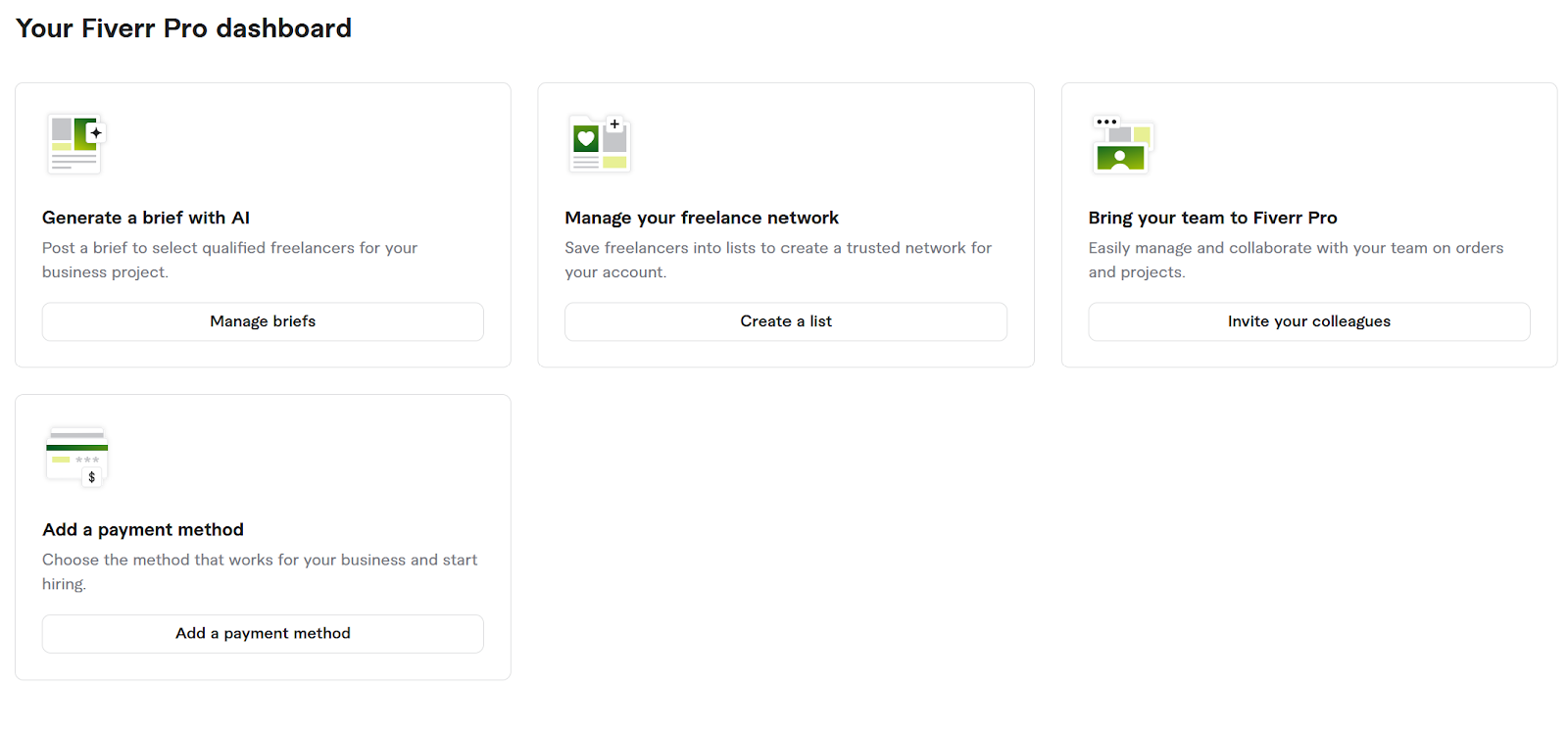
You’ll understand why below.
My Personal Experience Hiring Game Developers
I burned through over $50,000 on Fiverr in one year trying to build a third-person shooter in Unreal Engine 5 (UE5). The results? Let’s just say my bank account cried louder than my gaming PC.

Four months in, I thought I’d struck gold. A developer with a five-star portfolio and UE5 work. Their previous games looked solid. We shook digital hands on a fixed-price deal with clear milestones.
The honeymoon phase lasted about three weeks. Their initial character controller worked. I started planning my Game Awards acceptance speech.
Then reality crashed the party.
What I got back was a buggy mess that screamed amateur hour. Basic game functions crashed randomly. The blueprints (visual code) looked like digital spaghetti — tangled, messy, and impossible to build upon.
Not once did they ask clarifying questions. They just nodded along, then built something completely different. I found myself explaining concepts that any experienced UE5 developer should know in their sleep.
“This isn’t what we agreed on,” I said.
“I’ll fix it,” they promised.
“But I’m sick this week,” they added two days later. “Family emergency” came the week after that. “Computer issues” rounded out the excuse trifecta.
Narrator: They did not fix it.
Their responses slowed from days to weeks. Then they vanished like my hopes for a finished game. Ghost Mode: Activated.
To be fair, Fiverr isn’t a complete wasteland. Two freelancers actually delivered solid work on time. The difference? I hired them for hyper-specific tasks, not broad game systems. Small scope, clear deliverables, defined success. And it had absolutely nothing to do with code (environment and character design).
The Pros of Hiring Developers On Fiverr
Despite my game dev mishaps, Fiverr offers some genuine advantages for the right projects. Let’s break down what keeps customers on its platform.
Budget-Friendly Rates for Specific Tasks
Need a quick WordPress fix? A simple API integration? Fiverr shines here. Developers offer fixed-price packages starting at $25-50 for basic tasks. You won’t find these rates on traditional hiring platforms.
For perspective: A friend hired a developer to create a custom WordPress plugin for $200. The same work would’ve cost $800+ through a development agency.
Speed of Getting Started
Post your requirements at 9 a.m., start chatting with developers by lunch. No lengthy contracts or procurement processes. One dev started my project within two hours of our first message.
Protected Payments
Fiverr holds your payment in escrow until you approve the work. When one of my projects went sideways, I got my money back within 48 hours. The refund system does work.
Clear, Upfront Pricing
Every gig lists exact prices and deliverables. No surprise invoices or scope creep charges. You see precisely what you’ll get and what you’ll pay before hitting “Order.”
Global Talent Pool Access
Need someone who knows a niche technology? Fiverr’s massive developer pool helps. I found developers for specific game development tasks that local agencies wouldn’t care to look at. If it’s not a big project, they’re not interested.
Simple Project Management
The built-in messaging, file sharing, and milestone system keep everything organized. No juggling multiple apps or complicated project management tools.
The Cons of Hiring On Fiverr
Let’s get real about where Fiverr falls short. After spending $50K on the platform, I’ve seen patterns emerge that every tech leader should know about.
Lack of Serious Technical Vetting
Anyone with an email address and a government-issued photo ID can create a developer profile. No code tests. No skill verification. Just upload a portfolio (that might not even be yours) and start selling. This explains why I met “senior UE5 developers” who couldn’t handle basic game mechanics.
The Overpromise-Underdeliver Loop
“Yes, I can do that!” becomes their default response to everything. Need complex AI systems? “No problem!” Multiplayer integration? “Easy!” Then reality hits, and suddenly your “experienced” developer discovers they’re in way over their head.
Communication Black Holes
Messages go from instant replies to radio silence for no apparent reason (outside of the dev drowning in their inexperience). When developers realize they can’t deliver, many choose ghosting over honest communication. Good luck getting updates on your project timeline.
Quality Control Issues
Star ratings tell half the story. A developer might have 5 stars for building 2D platformers in Construct but tackle your complex UE5 shooter anyway. You won’t discover their limitations until after you’ve paid and waited weeks for unusable code.
The Excuse Encyclopedia
“My grandmother’s internet is down.” “My dog ate my backup drive.” “Mercury is in retrograde.” The creativity some developers show in making excuses could power a small indie game studio. If only they put that energy into actual development.
Complex Projects Need Not Apply
Fiverr works for small, defined tasks. But larger projects? They’re like trying to build a AAA game with string and duct tape. The platform just isn’t built for complex, evolving project requirements.
Justin J. seems to agree with my sentiment:
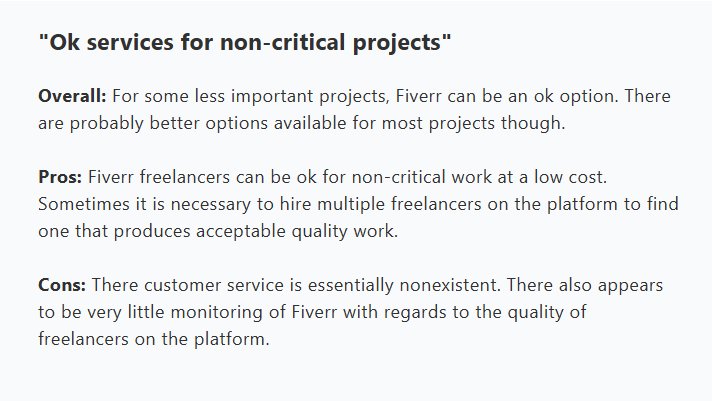
The Hidden Time Suck
You’ll spend hours explaining basic concepts that any experienced developer should know. Then more hours fixing their “fixes.” By the end, you could’ve learned UE5 yourself and built half the game.
What Projects Work on Fiverr?
After burning through enough cash to buy a luxury gaming PC, I’ve learned exactly what Fiverr developers can (and can’t) handle. Let’s break it down.
Projects That Work:
- Quick Bug Fixes: Found a pesky UI glitch? Need a quick performance optimization? These focused, well-defined tasks often succeed because they have clear success criteria.
- Simple Feature Add-ons: Adding a contact form to your website or implementing a basic login system? Perfect. These standalone features with minimal integration requirements fit Fiverr’s model.
- Basic Frontend Updates: UI tweaks, responsive design fixes, or simple animations usually work well. They’re visual, easily testable, and don’t require deep system knowledge.
- Prototype Development: Want to test a simple game concept or app idea? Fiverr developers can build basic prototypes when you’re not ready for full development.
Projects That Don’t Work:
- Complex Development: My $50K lesson — building a full game with multiple systems, complex mechanics, and polished gameplay? Save yourself the headache. Fiverr’s gig-based structure breaks down for projects needing constant iteration.
- Mission-Critical Systems: Need reliable, scalable backend architecture? Looking for secure payment processing? These aren’t projects for a platform where developers might ghost you mid-development.
- Long-Term Development: Any project requiring consistent development over months needs stable, reliable talent. Fiverr’s project-based structure works against building lasting development relationships.
- Integration-Heavy Projects: Systems touching multiple services, requiring deep architectural knowledge, or needing careful performance optimization? These projects need more oversight than Fiverr’s model allows.
The sweet spot? Small, defined tasks with clear deliverables. The moment your project needs ongoing collaboration or complex system understanding, look elsewhere (like Lemon.io).
What Other Tech Leaders Say About Fiverr
Let’s look beyond my experience. Here’s what other tech “head hunters” say about hiring developers on Fiverr in 2025.
Mixed Reviews
Capterra reviews tell a familiar story:
Fiverr freelancers can be OK for non-critical work at a low cost. Sometimes you need to hire multiple freelancers to find one with acceptable quality.
Another client counters with a common complaint:
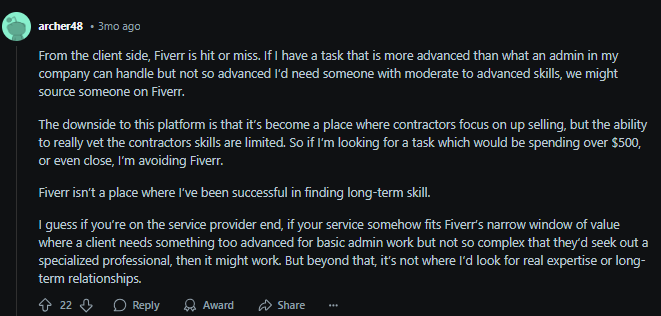
Then this client confirms what I learned the hard way:
For small tasks, this is an excellent service. I’ve had great success with tech fixes and template customizations.
A Success Story
Not all experiences mirror mine. On Reddit’s r/Entrepreneur, one client shared:
My company has two devs from Fiverr who are now equity partners. Affordable for proving concepts without huge upfront costs.
The Consensus
Reading through hundreds of reviews across platforms, the pattern matches my experience:
- Small, specific tasks usually succeed
- Complex projects often fail
- Quality varies dramatically
- Success requires careful vetting
Most tech hirers agree: Fiverr works for bite-sized development tasks but becomes risky for complex projects needing sustained development work.
How Fiverr Stacks Up Against the Competition
Let’s see how Fiverr compares to other platforms for hiring developers in 2025.
Fiverr vs. Upwork: The Gig Economy Titans
Upwork takes a fundamentally different approach to developer hiring:
Feature |
Fiverr |
Upwork |
|---|---|---|
Project Structure |
Primarily fixed-price packages (hourly only for Pro) |
Both hourly and fixed-price contracts |
Hiring Process |
Browse and purchase gigs directly |
Post jobs and review proposals—more control but more time |
Developer Quality |
Minimal vetting, inconsistent quality |
More detailed profiles and work history, slightly better vetting |
Platform Security |
Basic payment protection |
More comprehensive security with work diaries and milestone payments |
Cost Structure |
5.5% service fee |
Upwork client fee is 5% (3% for ACH, 8–10% for Business Plus) |
Best for: Upwork generally works better for longer-term projects with evolving requirements, while Fiverr excels at quick, clearly defined tasks.
Fiverr vs. Toptal: Budget vs. Premium
Toptal positions itself as the high-end alternative:
Feature |
Fiverr |
Toptal |
|---|---|---|
Talent Quality |
No formal vetting process |
Claims to accept only the “top 3%” with rigorous vetting |
Developer Cost |
$15-100+/hour, wide range |
$60-150+/hour, premium pricing |
Project Support |
Self-service, minimal guidance |
Talent matching and hands-on project management |
Risk Level |
No formal trial period |
Offers trial period with qualified developers |
Specialization |
General marketplace with many categories |
Focuses on software development, design, and finance |
Best for: Toptal makes sense for business-critical projects where quality outweighs cost concerns. Fiverr works better for budget-conscious tasks where some quality risk is acceptable.
Fiverr vs. Lemon.io: The Balanced Alternative
Lemon.io offers a middle path between Fiverr’s budget approach and Toptal’s premium model:
Feature |
Fiverr |
Lemon.io |
|---|---|---|
Developer Vetting |
No formal vetting process |
Thorough technical interviews and skills assessment |
Project Matching |
Self-service model |
Matches you with developers based on project needs |
Specialization |
General marketplace with many categories |
Focuses exclusively on development talent |
Communication Setup |
No verification of communication skills |
Verifies English proficiency and communication skills |
Cost Structure |
$15-100+/hour, variable quality |
$50-120/hr, top 1% talent |
The Bottom Line
Each platform serves different needs:
- Fiverr: Quick, defined tasks at budget prices (with quality risks)
- Upwork: Flexible projects with more control (but more time invested)
- Toptal: Premium talent for mission-critical work (at premium prices)
- Lemon.io: Quality-vetted developers at mid-range prices (for the quality-budget balance)
The right choice depends on your specific project needs, budget constraints, and risk tolerance.
The Final Word: Should You Hire Developers on Fiverr?
Fiverr isn’t inherently good or bad—it’s a tool with specific uses. After spending over $50K and working with numerous developers, here’s my verdict:
Use Fiverr when:
- You need quick, well-defined tasks completed
- You have a limited budget for non-critical development
- You can clearly articulate exactly what you need
- You’re willing to try multiple developers to find the right fit
Look elsewhere when:
- You’re building complex systems or games
- Quality and reliability are non-negotiable
- Your project requires ongoing collaboration
- You lack the technical skills to evaluate code quality
For simple website tweaks or basic feature additions, Fiverr can work beautifully. For anything more complex, consider platforms with stronger vetting processes like Lemon.io that bridge the gap between affordability and reliability.
The right platform depends on your specific needs, but the wrong choice can cost far more than the initial savings.
Looking for more alternatives? Check here.









